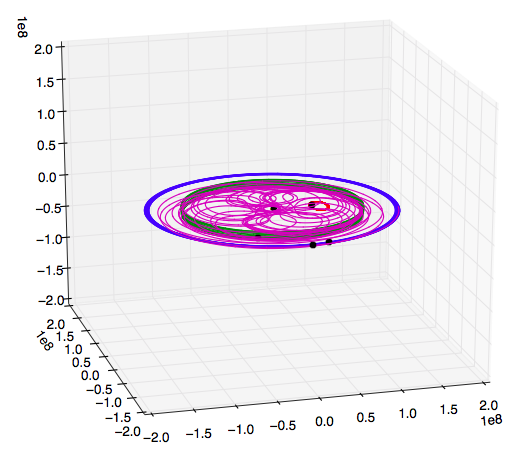In the question Is the Parker Solar Probe's semimajor axis being so close to that of Mercury's just coincidence? Does it help somehow? I used a Python script to plot the heliocentric orbit of the Parker Solar Probe in a frame rotating with Mercury's mean anomaly.
To do this I manually downloaded state vectors from Horizons as text files and then imported them, decoded the format, and converted to numpy arrays for simple processing and plotting.
Could someone show a specific example of how to get those state vectors into a numpy array using astroquery.jplhorizons? I've just learned in this answer of this package's existence.
This way I can just use np.save() or some other method to save the data for future, faster plotting or analysis.
Specifically, the data should be defined as follows:
start 2018-Aug-13 00:00:00
stop 2025-Aug-31 00:00:00
step 1 hour
Solar System Barycenter
Ecliptic and Mean Equinox of Reference
km and km/sec
csv format
x, y, z, vx, vy, vz (state vectors)
Objects: Sun, Mercury, Venus, Earth Geocenter, Parker Solar Probe
def makecubelimits(axis, centers=None, hw=None):
lims = ax.get_xlim(), ax.get_ylim(), ax.get_zlim()
if centers == None:
centers = [0.5*sum(pair) for pair in lims]
if hw == None:
widths = [pair[1] - pair[0] for pair in lims]
hw = 0.5*max(widths)
ax.set_xlim(centers[0]-hw, centers[0]+hw)
ax.set_ylim(centers[1]-hw, centers[1]+hw)
ax.set_zlim(centers[2]-hw, centers[2]+hw)
print "hw was None so set to:", hw
else:
try:
hwx, hwy, hwz = hw
print "ok hw requested: ", hwx, hwy, hwz
ax.set_xlim(centers[0]-hwx, centers[0]+hwx)
ax.set_ylim(centers[1]-hwy, centers[1]+hwy)
ax.set_zlim(centers[2]-hwz, centers[2]+hwz)
except:
print "nope hw requested: ", hw
ax.set_xlim(centers[0]-hw, centers[0]+hw)
ax.set_ylim(centers[1]-hw, centers[1]+hw)
ax.set_zlim(centers[2]-hw, centers[2]+hw)
return centers, hw
class Thing(object):
def __init__(self, name):
self.name = name
def rotate_it(vec, theta):
cth, sth = [f(theta) for f in (np.cos, np.sin)]
x, y, z = vec
xr = cth*x - sth*y
yr = cth*y + sth*x
return np.vstack((xr, yr, z))
import numpy as np
import matplotlib.pyplot as plt
from mpl_toolkits.mplot3d import Axes3D
fnames = ['Parker Solar Probe Sun 1h horizons_results.txt',
'Parker Solar Probe Mercury 1h horizons_results.txt',
'Parker Solar Probe Venus 1h horizons_results.txt',
'Parker Solar Probe Earth 1h horizons_results.txt',
'Parker Solar Probe Spacecraft 1h horizons_results.txt']
names = ['Sun', 'Mercury', 'Venus', 'Earth', 'Parker']
halfpi, pi, twopi = [f*np.pi for f in [0.5, 1.0, 2.0]]
degs, rads = 180./pi, pi/180.
AU = 149597870.700 # kilometers
things = []
JDs, posns, vels, linez = [], [], [], []
for name, fname in zip(names, fnames):
with open(fname, 'r') as infile:
lines = infile.read().splitlines()
iSOE = [i for i, line in enumerate(lines) if "$$SOE" in line][0]
iEOE = [i for i, line in enumerate(lines) if "$$EOE" in line][0]
print iSOE, iEOE, lines[iSOE], lines[iEOE]
lines = [line.split(',') for line in lines[iSOE+1:iEOE]]
JD = np.array([float(line[0]) for line in lines])
pos = np.array([[float(item) for item in line[2:5]] for line in lines])
vel = np.array([[float(item) for item in line[5:8]] for line in lines])
pos, vel = [thing.T for thing in pos, vel]
thing = Thing(name)
things.append(thing)
thing.JD = JD
thing.pos = pos
thing.vel = vel
thing.lines = lines
Sun, Mercury, Venus, Earth, Parker = things
theta_M = np.arctan2(Mercury.pos[1], Mercury.pos[0])
theta_P = np.arctan2(Parker.pos[1], Parker.pos[0] )
T_mercury = 87.969 * 24. # hours
JDx = 2459597.5
iJDx = 30096
theta_x0 = theta_M[iJDx]
hours_x = np.arange(len(theta_M), dtype=float) - iJDx
theta_Mx = theta_x0 + twopi * hours_x / T_mercury
for thing in things:
thing.pos_rM = rotate_it(thing.pos, -theta_M)
thing.vel_rM = rotate_it(thing.vel, -theta_M)
thing.pos_rMx = rotate_it(thing.pos, -theta_Mx)
thing.vel_rMx = rotate_it(thing.vel, -theta_Mx)
thing.pos_rP = rotate_it(thing.pos, -theta_P)
thing.vel_rP = rotate_it(thing.vel, -theta_P)
JD_today = 2458360.5 # 2018-Aug-30
i_today = np.argmax(Earth.JD >= JD_today)
i_08_Nov_2024 = np.argmax(Earth.JD >= 2460622.5)
colors = '-y', '-r', '-g', '-b', '-m'
if True:
fig = plt.figure() # [12, 10]
ax1 = fig.add_subplot(2, 1, 1)
for thing, co in zip(things, colors):
x, y, z = thing.pos_rMx
ax1.plot(x, y, co)
if True:
ax1.plot(x[i_today:i_today+1],
y[i_today:i_today+1], 'ok', markersize=8)
ax1.set_xlim(-1.6E+08, 1.6E+08)
ax1.set_ylim(-1.6E+08, 1.6E+08)
ax2 = fig.add_subplot(2, 1, 2)
i_start = i_08_Nov_2024
for thing, co in zip(things, colors):
x, y, z = thing.pos_rMx[:, i_start:]
ax2.plot(x, y, co)
if False:
ax2.plot(x[i_today:i_today+1],
y[i_today:i_today+1], 'ok', markersize=8)
ax2.set_xlim(-1.6E+08, 1.6E+08)
ax2.set_ylim(-1.6E+08, 1.6E+08)
plt.show()
if True:
fig = plt.figure(figsize=[10, 8]) # [12, 10]
ax = fig.add_subplot(1, 1, 1, projection='3d')
for thing, co in zip(things, colors):
x, y, z = thing.pos_rM
ax.plot(x, y, z, co)
ax.plot(x[i_today:i_today+1],
y[i_today:i_today+1],
z[i_today:i_today+1], 'ok')
c, h = makecubelimits(ax, centers=(0, 0, 0), hw=None)
print c, h
plt.show()

